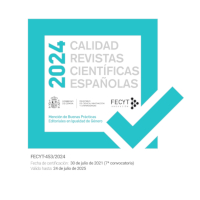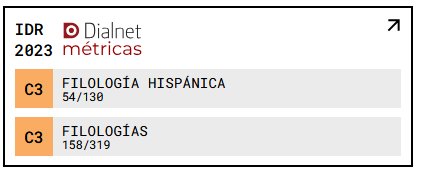Género y originalidad estilística de la poesía kazaja de la primera mitad del siglo XX
DOI:
https://doi.org/10.18172/cif.6323Palabras clave:
Movimiento nacional de liberación, cuestiones filosóficas, originalidad de la versificación, poesía kazaja, poesía nómadaResumen
El artículo explora las características únicas de la poesía kazaja de la primera mitad del siglo XX, caracterizada por su versificación particular y el reflejo del movimiento de liberación nacional. Esta poesía incorpora temas filosóficos y presenta al individuo como parte del universo dentro de un sistema de valores vitales. El estudio sitúa la poesía kazaja en el contexto de la literatura mundial, enfatizando sus raíces nómadas y su influencia en el desarrollo literario. Se emplean métodos analíticos y comparativos para examinar las características semánticas y estructurales del verso kazajo, junto con la influencia de las condiciones políticas e históricas. La investigación subraya el papel de la poesía como herramienta cultural y educativa, fomentando la conciencia histórica, el pensamiento crítico y la apreciación de la identidad nacional. Al estudiar la originalidad del género y el estilo, el artículo apoya programas educativos que promueven la competencia cultural y la sensibilidad literaria.
Descargas
Citas
Abril, J. C. (2025). Culture Efficacy: An Alternative to Collective Efficacy. Review of Law and Social Sciences, 3(1), 155-177. DOI: https://doi.org/10.71261/rlss/31.155.177
Altai, A. D., and Aituganova, S. S. (2019). Features of Kazakh literature in the XV-XVIII centuries. International Academy Journal Web of Scholar, 7(37), 25-33.
Altybaeva, S. M. (2018). Казахская проза периода независимости: традиция, новаторство, перспективы [Kazakh prose of the period of independence: Tradition, innovation, prospects]. Gylym.
Asankulova, B. S. (2012). Motives of moral and legal education in the work of Kazakh zhyrau. In Pedagogical skills: Materials of the I International Scientific Conference (pp. 362-363). Buki-Vedi.
Beisebayev, A. (1992). Национальное и интернациональное в современной Казахской поэзии: (60-80 годы) [National and international in modern Kazakh poetry (60-80 years)]. Thesis for the degree of PhD in Philological Sciences. Kazakh National University.
Belger, G. (2006). Spiritual shepherds of the nation. Thought, 3, 72-80.
Denys, I. (2024). Language as an important means of information encoding. Library Science. Record Studies. Informology, 20(1), 8-11. DOI: https://doi.org/10.63009/lsrsi/1.2024.08
Gaziev, I. M. (2008). The origin of professionalism in the musical culture of the ancient Turks. Bulletin of the South Ural State Humanitarian and Pedagogical University, 12, 181-183.
Idelbaev, M. K. (2018). Professional improvisational creativity in the literature of Turkic authors. Bulletin of the North-Eastern Federal University named after M.K. Ammosov: Epic Series, 2, 5-9.
Kanapyanov, B. M. (2020). “Абай вдохнул в пространство души казахское самосознание…” [“Abai breathed Kazakh self-consciousness into the space of the soul...”]. Profile, 5, 2-4.
Kongyratbay, T. A. (2021). Some problems of ethnic study of the heroic epic. Eposovedenie, 24(4), 15-22. DOI: https://doi.org/10.25587/e4294-4960-9721-z
Kongyratbay, T. A. (2022). Once again about the epic heritage of KorKuT. Eposovedenie, 2022(2), 28-39. DOI: https://doi.org/10.25587/n8974-5171-2692-o
Koshekova, A. A., Alpysbay, S. E., and Chakenova, B. A. (2016). The emergence of zhyrau and its activities. Actual Problems of the Humanities and Natural Sciences, 3-2, 136-139.
Litvinenko, V. V., and Nazarova, O. V. (2001). Reader on Kazakh literature [Хрестоматия по казахской литературе]. Vzglyad.
Magauin, M. (1987). Песни степей [Songs of the steppes]. In Poetry of zhyrau. Poems of Kazakh poets of the XҮ-XҮІІІ centuries (pp. 6-10). Zhalyn.
Mamraev, B. (2020). Символизм в казахской литературе [Symbolism in Kazakh literature]. Sozvuchie.
Mukhametshina, R. F., and Galimullina, A. F. (2014). Inculcation of bimental personality in context of cultural dialogue. Middle – East Journal of Scientific Research, 20(12), 2135-2138.
Mukhametzyanova, L. K. (2012). Роль информанта носителя эпической традиции в книжных дастанах татар Поволжья в популяризации национального эпоса [The role of the informant of the bearer of the epic tradition in the book dastans of the Volga Tatars in the popularization of the national epos]. Bulletin of the Chuvash University, 2, 337-340.
Musabekov, E. (1984). Some stylistic features of modern Kazakh poetry. Kazakstai.
Nurgalieva, K. (2016). The main stages of the formation and development of ethnoinstrumentology in Kazakhstan. Kurmangazy Kazakh National Conservatory.
Orazbayeva, N. S. (2015). Национальная самобытность Казахстана в художественных и документальных текстах конца XIX - первой половины XX веков [The national identity of Kazakhstan in artistic and documentary texts of the late XIX – first half of the XX centuries]. Eurasian National University named after L.N. Gumilyov.
Pancer-Cybulska, E., and Zlenko, Ya. (2024). The history of archival affairs in different countries: A comparative analysisof structures and organisational methods. Society. Document. Communication, 9(4), 48-61.
Romaniuk, O., and Yavorska, L. (2022). Complimenting behaviour in young adults’ first impression scripts. Analele Universitatii din Craiova - Seria Stiinte Filologice, Lingvistica, 44(1-2), 168-187. DOI: https://doi.org/10.52846/aucssflingv.v44i1-2.58
Serikzhanova, A., Nurtazina, R., Serikzhanova, I., Bukharbay, B., and Taitorina, B. (2024). Evolving Political Cultures in Kazakhstan, Uzbekistan, and Kyrgyzstan: Trends and New Paradigms. Journal of Ethnic and Cultural Studies, 11(3), 1-24. DOI: https://doi.org/10.29333/ejecs/1914
Shashkina, G., Ibraeva, Z., Tussupova, A., Zhapanova, M., and Anichshenko, O. (2025). Flower Representations in the Lyrics of A.A. Fet. Open Cultural Studies, 9(1), 20250047. DOI: https://doi.org/10.1515/culture-2025-0047
Sheryazdanova, G., Nurtazina, R., Byulegenova, B., Serikzhanova, A., and Dzhunusova, A. (2024). Socioeconomic and Political Causes of Youth Radicalization during the January 2022 Events in Kazakhstan. Global Perspectives, 5(1), 120495. DOI: https://doi.org/10.1525/gp.2024.120495
Shynkaruk, V. (2024). Functional characteristics of interrogative discursive utterances. International Journal of Philology, 28(1), 6-15. DOI: https://doi.org/10.31548/philolog15(1).2024.01
Stadnik, O. (2024). Cultural and sociological studies: Interdisciplinary and transdisciplinary fields. Culture and Contemporaneity, 26(2), 30-38. DOI: https://doi.org/10.63009/cac/2.2024.30
Toktagazin, M. B., Turysbek, R. S., Ussen, A. A., Nurtazina, R. A., Korganbekov, B. S., and Hradziushka, A. A. (2016). Modern internet epistolary in information and media discourse. Mathematics Education, 11(5), 1305-1319.
Vakulyk, I. (2020). Peculiarities of poetic translations of neoclassic. International Journal of Philology, 24(4), 64-69.
Velyka, A., and Birillo, I. (2024). Innovative features of corporate identity development. Culture and Contemporaneity, 26(1), 76-86. DOI: https://doi.org/10.63009/cac/1.2024.76
Zhanabaev, K. (2016). Об особенностях развития казахской поэзии в XV-XVIII вв. Общая характеристика [On the peculiarities of the development of Kazakh poetry in the XV-XVIII centuries. General characteristics]. Scientific Notes of the Khujand State University named after academician B. Gafurov. Humanities, 2, 153-155.
Zhantasova, Z. T., Kulanova, S. Sh., Uten, A., Omarov, N. K., and Eltayeva Zh. K. (2020). Развитие казахской литературы в 19 веке [Development of Kazakh literature in the 19th century]. Bulletin of Science and Education, 9(87), 5-7.
Zharikbaev, K. B., and Kaliev, S. K. (1995). Антология педагогической мысли Казахстана [Anthology of the pedagogical thought of Kazakhstan]. Rauan.
Descargas
Publicado
Cómo citar
Número
Sección
Licencia
Derechos de autor 2025 Mukhit Kozhashev, Alua Temirbolat, Sovetkhan Tleubayev, Karlygash Aisultanova, Ardak Sargeltayeva

Esta obra está bajo una licencia internacional Creative Commons Atribución 4.0.
El autor o autora conserva todos los derechos sobre su artículo y cede a la revista el derecho de la primera publicación, no siendo necesaria la autorización de la revista para su difusión una vez publicado. Una vez publicada la versión del editor el autor está obligado a hacer referencia a ella en las versiones archivadas en los repositorios personales o institucionales.
El artículo se publicará con una licencia Creative Commons de Atribución, que permite a terceros utilizar lo publicado siempre que se mencione la autoría del trabajo y la primera publicación en esta revista.
Se recomienda a los autores/as el archivo de la versión de editor en repositorios institucionales.














